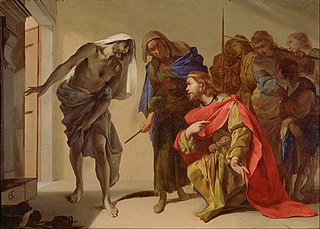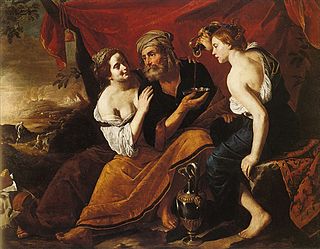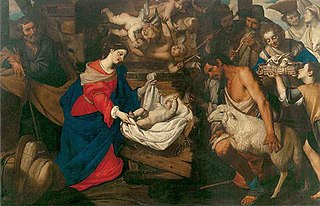
Luca Giordano was an Italian late-Baroque painter and printmaker in etching. Fluent and decorative, he worked successfully in Naples and Rome, Florence, and Venice, before spending a decade in Spain.

Antonello da Messina, properly Antonello di Giovanni di Antonio, but also called Antonello degli Antoni and Anglicized as Anthony of Messina, was an Italian painter from Messina, active during the Early Italian Renaissance. His work shows strong influences from Early Netherlandish painting, although there is no documentary evidence that he ever travelled beyond Italy. Giorgio Vasari credited him with the introduction of oil painting into Italy, although this is now disputed. Unusually for a southern Italian artist of the Renaissance, his work proved influential on painters in northern Italy, especially in Venice.

The Caravaggisti were stylistic followers of the late 16th-century Italian Baroque painter Caravaggio. His influence on the new Baroque style that eventually emerged from Mannerism was profound. Caravaggio never established a workshop as most other painters did, and thus had no school to spread his techniques. Nor did he ever set out his underlying philosophical approach to art, the psychological realism which can only be deduced from his surviving work. But it can be seen directly or indirectly in the work of Rubens, Jusepe de Ribera, Bernini, and Rembrandt. Famous while he lived, Caravaggio himself was forgotten almost immediately after his death. Many of his paintings were reascribed to his followers, such as The Taking of Christ, which was attributed to the Dutch painter Gerrit van Honthorst until 1990.

Jusepe de Ribera was a painter and printmaker, who along with Francisco de Zurbarán, Bartolomé Esteban Murillo, and the singular Diego Velázquez, are regarded as the major artists of Spanish Baroque painting. Referring to a series of Ribera exhibitions held in the late 20th century, Philippe de Montebello wrote "If Ribera's status as the undisputed protagonist of Neapolitan painting had ever been in doubt, it was not longer. Indeed, to many it seemed that Ribera emerged from these exhibitions as not simply the greatest Neapolitan artist of his age but one of the outstanding European masters of the seventeenth century." Jusepe de Ribera has also been referred to as José de Ribera, Josep de Ribera, and Lo Spagnoletto by his contemporaries, early historians, and biographers.

Claude-Joseph Vernet was a French painter. His son, Antoine Charles Horace Vernet, was also a painter.

Benvenuto Tisi was a Late-Renaissance-Mannerist Italian painter of the School of Ferrara. Garofalo's career began attached to the court of the Duke d'Este. His early works have been described as "idyllic", but they often conform to the elaborate conceits favored by the artistically refined Ferrarese court. His nickname, Garofalo, may derive from his habit of signing some works with a picture of a carnation.
Events from the year 1656 in art.
Gaspar Roomer was a prominent Flemish merchant, banker, art patron and art collector who was active in Naples in the 17th century.

Massimo Stanzione was an Italian Baroque painter, mainly active in Naples, where he and his rival Jusepe de Ribera dominated the painting scene for several decades. He was primarily a painter of altarpieces, working in both oils and fresco. His main subject matter was biblical scenes. He also painted portraits and mythological subjects. He had many pupils and followers as his rich color and idealized naturalism had a large influence on other local artists, such as Francesco Solimena. In 1621 Pope Gregory XV gave him the title of Knight of the Golden Spur and Pope Urban VIII made him a knight of St. John around 1624 and a knight of the Order of Christ in 1627. From then on, he liked to sign his works as "EQUES MAXIMUS".

François de Nomé was a French painter of the Baroque period, active mainly in Naples.

Bernardo Cavallino (1616–1656) was an Italian painter and draughtsman. He is regarded as one of the most original painters active in Naples during the first half of the 17th century.

Andrea Vaccaro was an Italian painter of the Baroque period. Vaccaro was in his time one of the most successful painters in Naples, a city then under Spanish rule. Very successful and valued in his lifetime, Vaccaro and his workshop produced many religious works for local patrons as well as for export to Spanish religious orders and noble patrons. He was initially influenced by Caravaggio, in particular in his chiaroscuro and the naturalistic rendering of his figures.

Antonio de Bellis was an Italian painter from Naples, active in the Baroque period. Along with Jusepe de Ribera, Bernardo Cavallino and Massimo Stanzioni he was one of the major artists working in Naples in the first half of the seventeenth century, under the influence of the painter Caravaggio.

Jacob Symonsz. Pynas, was a Dutch Golden Age painter.

Hendrick de Somer (1602–c.1655) was a Flemish painter who spent most of his life and career in Italy. He was mainly active in Naples.

Monsù Desiderio is the name formerly given to an artist believed to have painted architectural scenes in a distinctive style in Naples in the early seventeenth century. The term monsù, a corruption of the French monsieur, was often used by Neapolitan historians to denote a painter of foreign origin.
Blas Olleros y Quintana was a Spanish figure painter and landscape painter who worked primarily in Italy as a watercolorist. He is best known for his Neapolitan scenes and Orientalist works.

Pacecco De Rosa was an Italian painter, active in Naples.

Theatrum Pictorium, or Theatre of Painting, is a short-hand name of a book published in the 1660s by David Teniers the Younger for his employer, the Archduke Leopold Wilhelm of Austria. It catalogs 243 Italian paintings in the Archduke's collection of over 1300 paintings. The paintings are reproduced by engravings made by various engravers after reduced-size copies (modelli) created by Teniers. David Teniers' brother Abraham Teniers was involved in organizing the publication of the work. A second edition with page numbers was published in 1673.

Gallery of Archduke Leopold Wilhelm in Brussels is a 17th-century painting of Archduke Leopold Wilhelm's Italian art collection by the Flemish Baroque painter David Teniers the Younger, now held in the Schleissheim Palace.

















